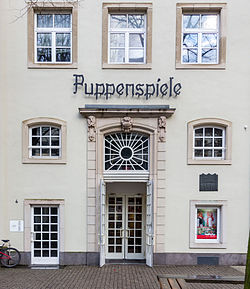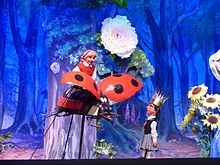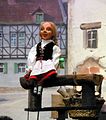Hänneschen Theater
| Hänneschen Theater | |

|
|
| location | |
| Address: | Eisenmarkt 2–4 |
| City: | Cologne |
| Coordinates: | 50 ° 56 '13 " N , 6 ° 57' 42" E |
| Architecture and history | |
| Opened: | July 29, 1938 (at today's location on Eisenmarkt) |
| Spectator: | 284 seats |
| Named after: | the stick puppet figure Hänneschen (1802) |
| Internet presence: | |
| Website: | haenneschen.de |
The Hänneschen Theater , officially the city of Cologne's puppet shows , is a traditional stick puppet theater on the Eisenmarkt in the southern Martinsviertel of Cologne 's Altstadt-Nord . With around 25 permanent employees - 14 of them are puppeteers - it is the puppet theater with the largest number of employees in Germany. It generates around 60 percent of its budget itself, making it by far the most efficient urban stage in Germany. For more than 20 years, the artistic director was the former actor, director and lawyer Heribert Malchers. Frauke Kemmerling (* 1967) has been her successor since December 1, 2012. Udo Müller has been the vice-intendant since 2013.
History of the house
The theater was founded in 1802 by the Bonn- born tailor Johann Christoph Winters in Mauthgasse. The beginnings of this puppet theater were simple nativity plays for children, which were performed during Advent .
Despite frequently changing venues, Winters was successful from the start. The Hänneschen Theater was already represented at the first carnival procession in Cologne in 1823 and is still there today. Among its competitors was u. a. Franz Andreas Millewitsch , who also opened a puppet theater in 1847 because he could not support his family by trading in fertilizers and spices. Despite the different spelling, this is a direct ancestor of the well-known folk actor Willy Millowitsch . When Winters died in 1862, Peter Josef Klotz , who was married to Winters' granddaughter, continued to run the theater. In 1919, the popular theater was closed after the death of the last member of this puppeteer family.
In 1925, at the endeavors of Konrad Adenauer and Carl Niessen , a commission to revive the Cologne puppet shows was founded, thanks to which the theater was reopened on October 9, 1926, under the sponsorship of the city as a puppet show of the city of Cologne , in the Rubens House at 10 Sternengasse . The painter Peter Paul Rubens spent his childhood in this house , and in 1642 the French ex-Queen Maria de Medici died there . The Hänneschen Theater has been located on the Eisenmarkt in Cologne's old town since July 29, 1938 , with a few interruptions during the war and post-war period . During the time of National Socialism , in addition to folk plays, puppet shows with racist and anti-Semitic content were performed in the Hänneschen Theater .
The fictional characters embody the typical characteristics of a Cologne native, such as Tünnes and Schäl , Hänneschen and Bärbelchen as well as other original personalities. In addition to the constantly changing pieces that are staged for adults and children, the puppet session is an important part of the Cologne Carnival . The dolls session is an annual spoof of the session Carnival: A carnival meeting , in addition to the usual figures of puppet theater play and the puppet versions of current Cologne Carnival sizes. Each presenter receives a blood sausage at the end of their performance . However, since there is only one sausage, the stuttering Speimanes has the task of removing it from the lecturer behind the stage, which often does not go off without screaming and fighting. Then he reappears on stage, often with a black eye or other traces of the fight, and proudly hands over the good piece to Schäl with the words: “Mr. PP President, de Woosch” (the audience calls: “De Woosch ").
In November 2015, the WDR decided not to broadcast the puppet session, which was traditionally broadcast on Carnival Tuesday, after 34 years for financial reasons. In October 2016, the private broadcaster RTL West announced that it would record the carnival session and show it in an open-air event during the carnival session . The first public viewing on the iron market with the loss m'r laache! Program took place on February 21, 2017. In June 2016, the Hänneschen Theater received the Rhineland Taler from the Rhineland Regional Association for its services to the cultural development of the Rhineland.
The main characters
The location of the plays is Knollendorf, a fictional town somewhere outside Cologne's gates.
- Aside from the puppet sessions, Hänneschen is the hero of most of the plays. Friendly, sincere and witty, but sometimes a little too enthusiastic, he is the identification figure for the children, especially in the afternoon performances.
- Bärbelchen is Hänneschen's girlfriend (in the children's performances in the afternoon, however, his sister), also a positive character with similar characteristics to Hänneschen.
- Tünnes , father of Köbeschen Schmitz, is calm, good-natured and a bit simple-minded, but actually not stupid. In his blue traditional smock he represents the rural-village type from the greater Cologne area.
- Schäl , the type of Cologne city dweller, is sufficiently characterized by its name. He has a strong squint and is also a bit pale in character (= wrong, bad, unsightly). Always wearing a tailcoat, he thinks he is smart and educated and thinks he can rip the villagers over the ear. His tricks usually go wrong, and in the end there isn't much left of his facade. He is the session president of the puppet sessions, only there the actual events usually pass him by. Schäl and Speimanes did not appear until 1850, while everyone else was there from the beginning. Schäl is the father of Röschen.
- Speimanes is, so to speak , the court jester of the theater troupe. Small in stature, hunchbacked and with a wet pronunciation, he has no respect for anyone and is not at a loss for any biting remarks - to the chagrin of Schäl in particular.
- Policeman Schnäuzerkowski that from the name, the offset to Cologne Prussian caricatured civil service, but on the Rhine-casual art for peace and order provides.
- Besteva and Bestemo , the grandparents.
- Köbeschen Schmitz is the son of the single Tünnes. Though small and delicate, he takes care of his often drunk father. He has made many of his father's views his own and likes to be precocious about them. He plays and quarrels with his girlfriend, Röschen Schäl.
- Röschen has difficulties keeping her father Schäl halfway on straight paths. But if her paternal inheritance comes through and she is involved in mischief, she always finds a way out of dangerous situations. Then with a sigh she says; "Peel it off a bastard, don't you think it's minge dad!"
- Picture gallery
Stage and fundus
The game is " hinger dr Britz " (literally: behind the balustrade), which is represented by a man-high, hydraulically retractable wooden wall. It covers the puppeteer. The stage is technically equipped in such a way that objects, puppets and backdrops can appear and disappear from and upwards as well as from and downwards, in addition to the usual horizontal possibilities. This is also often used by angels or the Christ Child , for ship sinks or castles that collapse and sink into the ground. The stage takes up practically the entire width of the venue. A puppeteer takes up more than four times as much space as his puppet without moving.
Most of the four to five kilogram dolls are carried on a carrying stick. So the steps of the puppeteers and running movements are transferred to the puppet. The right hand of the doll is usually provided with a guide rod, movements of the other hand and legs must be generated by body movements of the doll and centrifugal force . Some dolls, especially multi-legged animals and birds, also props, are moved differently, with up to six sticks being used, for example with crocodiles or snakes.
The heads of the dolls are carved from linden wood and colored with make-up, while the bodies usually only consist of a kind of anatomical skeleton that can be moved like a jointed doll , but much more easily. Your clothes are completely separate so that they can be changed as you like - even during the performances. The extremely detailed garments are made in our own workshop like the figures and the scenery.
In 2007, the Hänneschen Theater had around 800 puppets and around 1800 costumes. They are all from the time since World War II , as all older dolls and clothes were burned in the final nights of the bombing of the war. In the theater's archive, the books of past performances are stored far back in time, but also a large fund of plays that were never performed.
literature
- Hinger d'r Britz. Journal for the members of the Friends of the Cologne Hänneschen Theater , Friends' Association, Cologne 1.1990 ff.
- Max-Leo Schwering: The Cologne “Hänneschen” theater: history and Interpretation . 1st edition. JP Bachem Verlag, Cologne 1982, ISBN 3-7616-0642-7 , p. 167 .
- Frauke Kemmerling and Monika Salchert: Mieh Hätz like wood - 200 years of Kölsch Hännesche . 1st edition. Hermann-Josef Emons Verlag, Cologne 2002, ISBN 3-89705-237-7 , p. 215 .
Web links
- Hänneschen Theater
- Report on the puppet meeting 2017 in the Kölner Stadt-Anzeiger
- History of the Cologne Hänneschen Theater
- Report on the Christmas fairy tale 2013 on the online portal Köln Reporter
Individual evidence
- ↑ Main committee makes important personnel decisions. In: stadt-koeln.de. August 6, 2012, accessed February 8, 2016 .
- ↑ JB Heyn (ed.): Cologne address book . Cologne 1844, p. 219 .
- ↑ Frauke Kemmerling, Monika Salchert: Mieh Hätz like wood: new knowledge, old tradition - perpetual longing: 200 years - Kölsch Hännesche . 1st edition. Emons, Cologne 2002, ISBN 978-3-89705-237-6 , pp. 107 .
- ^ Richard Weber: Niessen, Carl. In: New German Biography. 19 (1999), pp. 241-243. (Online version) , accessed February 6, 2016.
- ^ Gerhard Dietrich: Chronicle 1888-1988: Museum, art and city in the mirror of the press . Ed .: Museum for Applied Art, City of Cologne. 1st edition. Publishing house of the city of Cologne, Cologne 1989, p. 99 .
- ↑ epoche-napoleon.net: Johann Christoph Winters , accessed on February 6, 2016.
- ↑ Werner Jung : The modern Cologne . 2nd Edition. JP Bachem Verlag, Cologne 2009, ISBN 978-3-7616-1590-4 , p. 225-228 .
- ^ A b Carl Dietmar and Werner Jung : Cologne. The great city history . 1st edition. Klartext, Essen 2015, ISBN 978-3-8375-1487-2 , p. 412 .
- ↑ ksta.de of July 28, 2013: Anniversary - The Hänneschen on the Nazi course , accessed on June 3, 2016
- ↑ Oliver Görtz: Cologne puppet session: WDR removes Hänneschen session from the program . In: Kölner Stadt-Anzeiger . ( ksta.de [accessed on February 28, 2017]).
- ↑ Hänneschen Theater: RTL West takes over production. Retrieved February 28, 2017 (English).
- ↑ Monika Salchert: After WDR exit: RTL-West records the puppet session from Hänneschen . In: Kölner Stadt-Anzeiger . ( ksta.de [accessed on February 28, 2017]).
- ↑ Open day: Public viewing for the Hänneschen puppet session . In: Kölner Stadt-Anzeiger . ( ksta.de [accessed on February 28, 2017]).
- ↑ Kölner Wochenspiegel from March 8, 2016: Watching the Hänneschen with mulled wine , accessed on June 1, 2016
- ↑ - Press release from June 2, 2016: Rhineland thaler for stories from Knollendorf , accessed on May 17, 2017
- ↑ Schnäuzerkowski , haenneschen.de
- ↑ Visit to the Hänneschen Theater on August 6, 2007. In: koelschakademie.finbot.com. Archived from the original on November 1, 2013 ; accessed on February 8, 2016 : "The theater's fund includes around 800 puppets, starting with Hänneschen and Bärbelchen, the entire Knollendorf population, [...]"










